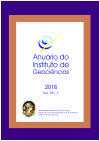Case Study of Intense Mesoscale Convective Systems Occurred between 02 and 03 January 2013 in the State of Rio de Janeiro: Structural and Thermodynamic Characteristics
DOI:
https://doi.org/10.11137/2016_2_57_76Keywords:
Mesoscale convective system, GOES, Radar.Abstract
This paper presents an analysis of the structural and thermodynamic characteristics of intense Mesoscale Convective Systems (MCS) that occurred in the State of Rio de Janeiro between 02 and 03 January 2013. These MCS caused floods and landslides in Metropolitan and Mountain Regions of Rio de Janeiro, with material and economic losses, dozens injured, and two fatal human losses. The analyzes were made using Geostationary Operational Environmental Satellite images in infrared spectrum (channel 4), the Forecasting and Tracking of Active Cloud Clusters method, images from radar at Pico do Couto, meteorological data from surface stations, and reanalyzes from National Center for Environmental Predictions. Results from satellite showed that the studied MCS were stimulated by a cold front that moved over southern of the State of Rio de Janeiro on 02 January. The MCS that reached Metropolitan and Mountain Regions of Rio de Janeiro initiated at 01:15 UTC of 03 January, acquired its own dynamic, and moved eastward with a mean velocity of around 11 m/s, travelling around 150 km between 01:15 UTC and 14:45 UTC of 03 January. This system reached the mountain region of the State of Rio de Janeiro with maximum intensity in the early morning at Xerem, Duque de Caxias. The MCS had a maximum total area of around 23200 km2 (170 km in extension) and maximum convective area of around 5600 km2, very cold cloud tops (< 200 K), eccentricities > 0,7 (semicircle), radar reflectivities “strong”, and a total rainfall of 224,6 mm in Xerem (from surface stations). Except by the MCS extension, its characteristics were similar to the Mesoscale Convective Complexes (MCC) studied in the literature. The thermodynamic and circulation fields showed strong moisture convergence and atmospheric instabilities over State of Rio de Janeiro, contributing to the formation of this severe storm. We have also observed circulation patterns similar to the ones found in MCC events described in the literature, with a Low Level Jet over Southeast South America and a High Level Jet in the subtropics.Downloads
Published
2016-06-23
Issue
Section
não definida
License
This journal is licensed under a Creative Commons — Attribution 4.0 International — CC BY 4.0, which permits use, distribution and reproduction in any medium, provided the original work is properly cited.
















 Except where otherwise noted, content on this site is licensed under a license
Except where otherwise noted, content on this site is licensed under a license 